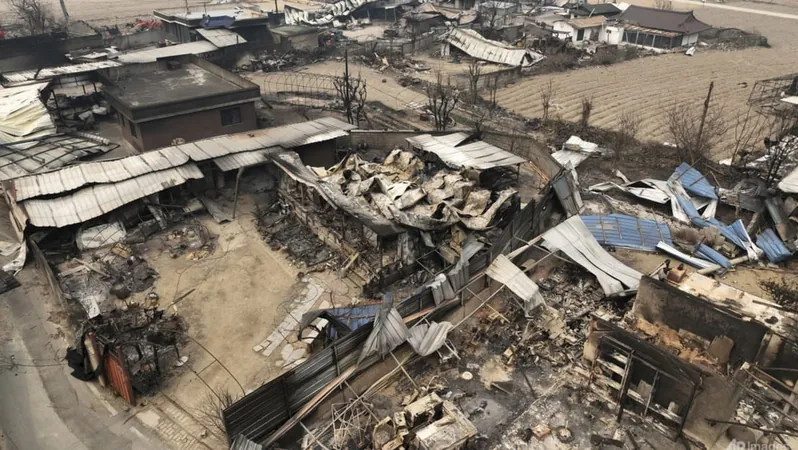
South Korea's Devastating Wildfires Claim Lives and Heritage: Community Struggles to Rise from the Ashes
2025-03-29
Author: Wei Ling
Andong, South Korea – Kim Dal-geun, a resident of Andong for over a decade, found his life turned upside down on March 25 when he was forced to evacuate his home alongside his wife, leaving only with their clothes. Their comfortable life, enriched by the city's vibrant culture and folk traditions, was shattered as they faced South Korea's deadliest wildfires on record.
These wildfires, which have ravaged North Gyeongsang province since the previous week, began in Uiseong county and have tragically claimed the lives of at least 28 people. The devastation has spread across an area larger than two-thirds of Singapore, with entire communities now left in ruins.
Among the most harrowing losses are several cultural heritage sites, including the destruction of Gounsa, a 1,300-year-old Buddhist temple. Many residents returned to their charred neighborhoods on Thursday to survey the damage and see if they could salvage anything. Kim, while mourning the loss of his home, felt a small glimmer of hope for his modest land where he grew chilies for a living.
"It hurts to witness all of this, but we have no choice but to press on. It's hard to put into words," Kim expressed with a heavy heart, grateful to have rescued his two dogs, even as others faced the anguish of leaving their pets behind.
The wildfires have wreaked havoc on at least 18 designated heritage sites, according to the Korea Heritage Service, prompting ongoing efforts from firefighters to protect any structures still standing. In a visit to Gounsa, National Assembly Speaker Woo Won-shik expressed his heartbreak over the temple’s destruction, emphasizing the urgent need for South Korea to strengthen its legal and institutional responses to such climate change-related disasters.
“This catastrophic event has made it clear we must rethink our strategies to combat fire risks brought on by climate change,” he stated. He also acknowledged the bravery and efforts of emergency responders, underscoring the necessity to provide comprehensive support for both the victims and preservation of their cultural heritage.
Reflecting on the damage, Beom Jong, the cultural director at Gounsa Temple, shared his devastation at the ruins. “We've never experienced anything like this in over a thousand years of our existence. Our headquarters has never faced such a calamity. Discussions are already underway on how best to address this crisis.”
Before the fires, Gounsa attracted 120,000 visitors annually, including Jin Yeo-shin, who has been a devoted worshipper for four decades. “It’s hard to articulate my feelings; I can only cry,” she lamented.
In addition to the destruction of these sites, the historic Hahoe Folk Village—a UNESCO World Heritage Site with a 500-year legacy—also issued evacuation orders. Resident Ryu Han Pae, who has lived there since 1949, noted the surprise and severity of the fire, which has altered the landscape of their beloved village.
“The extent of the devastation is beyond anything we could have imagined,” he remarked, acknowledging the efforts of authorities and residents in their coordinated response. “There is immense pride in our heritage, and it’s painful to witness the fire’s impact. My hope is that future generations never have to face such tragedies.”
As the affected communities begin to grapple with the aftermath of the wildfires, South Korea faces a significant challenge: how to rebuild lives, restore lost heritage, and address the looming threat of climate change. Communities are rallying together, embodying resilience in the face of disaster while expressing a collective hope that this catastrophe leads to stronger measures to protect their cultural treasures in the future.


 Brasil (PT)
Brasil (PT)
 Canada (EN)
Canada (EN)
 Chile (ES)
Chile (ES)
 Česko (CS)
Česko (CS)
 대한민국 (KO)
대한민국 (KO)
 España (ES)
España (ES)
 France (FR)
France (FR)
 Hong Kong (EN)
Hong Kong (EN)
 Italia (IT)
Italia (IT)
 日本 (JA)
日本 (JA)
 Magyarország (HU)
Magyarország (HU)
 Norge (NO)
Norge (NO)
 Polska (PL)
Polska (PL)
 Schweiz (DE)
Schweiz (DE)
 Singapore (EN)
Singapore (EN)
 Sverige (SV)
Sverige (SV)
 Suomi (FI)
Suomi (FI)
 Türkiye (TR)
Türkiye (TR)
 الإمارات العربية المتحدة (AR)
الإمارات العربية المتحدة (AR)